
The index page for the 1954 French flap section of this website is here.
Reference for this case: 22-Sep-54-Tulle.
Please cite this reference in any correspondence with me regarding this case.
Many French and even foreign newspapers had reported on September 24, 1954, and in the days that followed, that Mr. Besse, draftsman at the E.D.F. - state-run power co - in Tulle, had seen distinctly on "Friday night", around 11 p.m., above the city, "a flying saucer. Using powerful binoculars, he was able to follow, for a few moments, the moves of the craft which changed color, he says, three times in a few moments."
In the US newspaper Newark Star Ledger for September 24, 1954, the case was already mentioned; the full name of the witness was given: Mr. Jean Besse.
As most newspapers said: "Friday night", Aimé Michel, based on the newspaper La Croix for September 28, 1954, dated the case September 24, 1954, thus on what he thought was an alignment of cases beyond mere chance between Bayonne and Vichy on this date, his famous "BAVIC line".
The brief summary by Michel will be recopied many times with this date.
The "skeptical" ufologists Gérard Barthel and Jacques Brucker ensured in 1979 that the date of this case is doubtful and that "the observation is fugitive according to the witness", and that "in addition, Mr. Besse never had the pleasure of observing with binoculars!"
In 1997, ufologist Michel Jeantheau found in the local newspaper L'Echo de la Corrèze, of Tulle, for October 1, 1954, page 1, an article that dealt with this observation. He said that in this article, the witness himself spoke, interviewed by a reporter. His statement begins with these words: "On October 22, at 9:00 p.m., I returned from a short walk with my wife and my son, we had arrived on the Souilhac bridge when..."
But Jeantheau noted that the date "October 22" is a manifest error, the date should rather be September 22, since the newspaper was for October 1. He also notes that the hour indicated was 09:00 p.m., not 11:00 p.m.
[Ref. nsl1:] "NEWARK STAR-LEDGER" NEWSPAPER:
The paragraph underneath has been published in the daily newspaper The Newark Star-Ledger, New York, USA, on September 24, 1954.
[...]
Rainbow flying saucers are the rage in central France where draughtsman Jean Besse said he watched one Friday night through powerful binoculars. He said it changed color three times in a few seconds.
[...]
[Ref. ler1:] NEWSPAPER "L'EST REPUBLICAIN":
New "appearances" of "flying saucers" were reported yesterday.
Mr. Besse, draftsman at the E.D.F. [National power co.] in Tulle, saw distinctly Friday night, about 11 p.m., above the city, a flying saucer. Using powerful binoculars, he managed to follow during a few moments the evolutions of the machine that changed color, he said, three times in a few moments.
On the other hand, Mr. Mallet, owner of the Cevennes hotel in Le Puy, saw at the east of this city, a color-changing craft moving slowly and noiselessly, animated, it seemed, of a slight oscillation.
[Ref. brn1:] NEWSPAPER "LE BERRY REOUBLICAIN":
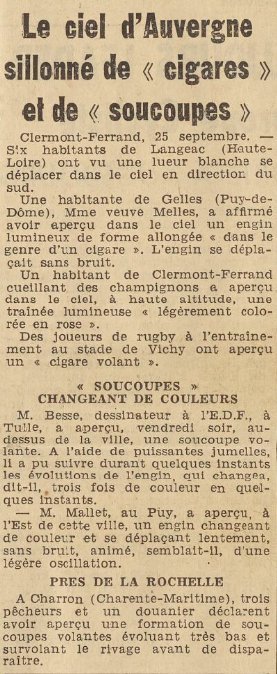
|
Clermont-Ferrand, September 25. -- Six residents of Langeac (Haute-Loire) saw a white glow moving through the sky heading south.
A resident of Gelles (Puy-de-Dôme), Mrs. Widow Melle, stated that she saw in the sky a luminous craft of elongated shape "like a cigar." The craft moved without making any noise.
A resident of Clermont-Ferrand who was picking mushrooms saw a luminous trail in the sky at high altitude, "slightly tinted pink."
Rugby players training at the stadium in Vichy saw a "flying cigar."
Mr. Besse, a draftsman at the E.D.F. in Tulle, saw a flying saucer over the city on Friday evening. Using powerful binoculars, he was able to observe the craft's movements for a few moments, during which it reportedly changed color three times.
Mr. Mallet, in Le Puy, saw to the east of the city a craft changing color and moving slowly and silently, apparently with a slight oscillation.
In Charron (Charente-Maritime), three fishermen and a customs officer reported seeing a formation of flying saucers flying very low and passing over the shore before disappearing.
[Ref. lpl1:] NEWSPAPER "LE PROVENCAL":
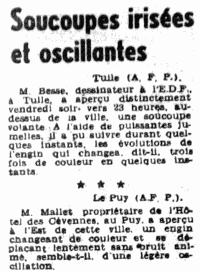
|
Tulle (A.F.P.).
Mr. Besse, draughtsman with the E.D.F. [state power co], in Tulle, saw distinctly Friday evening, at approximately 11 p.m., above the city, a flying saucer. Using powerful binoculars, he could follow during a few moments the evolutions of the machine which changed, he says, three times of color within a few moments.
* * *
Le Puy (A.F.P.):
Mr. Mallet, owner of the Hotel of the Cevennes, in Le Puy, saw in the East of this city, a machine changing color and moving slowly without noise animated apparently light oscillation.
[Ref. bpc1:] NEWSPAPER "LE BIEN PUBLIC":
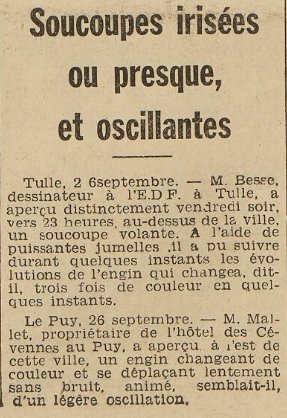
|
Tulle, September 26. -- Mr. Besse, a draftsman at the E.D.F. in Tulle, clearly saw a flying saucer Friday night around 11 p.m. above the city. Using powerful binoculars, he was able to follow the movements of the craft for a few moments, during which it changed color three times, he said, in just a few seconds.
Le Puy, September 26. -- Mr. Mallet, owner of the Hôtel des Cévennes in Le Puy, saw to the east of the city a craft that changed color and moved slowly, without noise, seemingly with a slight oscillation.
[Ref. tbt1:] NEWSPAPER "LE TELEGRAMME DE BREST":

|
The flying saucer epidemic continues to rage across France.
In Tulle, Mr. Besse, a draftsman at E.D.F., clearly saw a flying saucer above the city. Using powerful binoculars, he was able to follow the object's movements for a few moments. It changed color three times in just a few seconds, he said.
(CONTINUED ON PAGE 2).
[Ref. rln1:] NEWSPAPER "LE REPUBLICAIN LORRAIN":
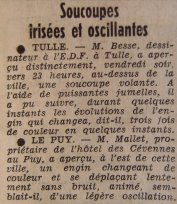
|
TULLE. -- Mr. Besse, a draftsman at the E.D.F. in Tulle, distinctly saw a flying saucer above the city on Friday evening around 11 p.m. Using powerful binoculars, he was able to observe the movements of the craft for a few moments. He stated that it changed color three times in just a few moments.
LE PUY. -- Mr. Mallet, owner of the Hôtel des Cévennes in Le Puy, saw, to the east of the city, a craft changing color and moving slowly and silently, apparently with a slight oscillating motion.
[Ref. cot1:] NEWSPAPER "COMBAT":

|
TULLE, September 26. -- Mr. Besse, a draftsman at E.D.F. in Tulle, clearly saw a flying saucer on Friday evening around 11 p.m., above the city. Using powerful binoculars, he was able to observe the craft's movements for a few moments. It changed color three times in quick succession, he said.
LE PUY. -- Mr. Mallet, a hotel owner in Le Puy, saw an object to the east of the city. It changed color and moved slowly and silently, appearing to wobble slightly.
CLERMONT-FERRAND. -- Six residents of Langeac (Haute-Loire) observed a white light moving through the sky in a southern direction.
A resident of Gelles (Puy-de-Dôme), Mrs. Widow Melles, claimed to have seen a luminous object in the sky, elongated in shape "like a cigar." The object moved without making a sound.
[Ref. ple1:] NEWSPAPER "LE PARISIEN LIBERE":
[...]
In Tulle, Mr. Besse, designer at the E.D.F. [national power company], distinctly saw a flying saucer on Friday evening around 11 p.m. Using powerful binoculars, he could follow the evolutions of the machine during a few moments, it changed it color, he said, three times in a few moment.
[...]
[Ref. lcx1:] NEWSPAPER "LA CROIX":

|
For several hundred meters, a flying saucer followed a car, at least that is what Mr. R. Patient, assistant inspector of the P.T.T in Bourges, says.
Thursday evening, Mr. Patient going by car, to Vasselay, in the company of his wife and children, aged 11 and 10 years old, saw, that night, in the hamlet of Jou, north of Bourges, a peculiar object of extreme brilliance, seeming to descend into a field.
At the alleged landing spot, a glowing reflection appeared. An incandescent filament about 50 meters long was in the center of the object, hemispherical, the diameter of which approached about fifteen meters.
For twenty to thirty seconds it was darkness. Then suddenly there was a new glow above the horizon. Mr. Patient, who had stopped his car, left followed silently, for a few hundred meters, by the object which then disappeared.
Other witnesses in Bourges, in Saint-Dolchard and in Vierzon, claim to have also seen a luminous object at concordant hours.
Also, Mr. Besse, designer at the E.D.F., in Tulle, saw, distinctly, Friday evening, around 11 p.m., above the city, a flying saucer. Using powerful binoculars, he was able to follow, for a few moments, the maneuvers of the craft which changed, he said, three times its color in a few moments.
[Ref. nnm1:] NEWSPAPER "LE NOUVEAU NORD MARITIME":
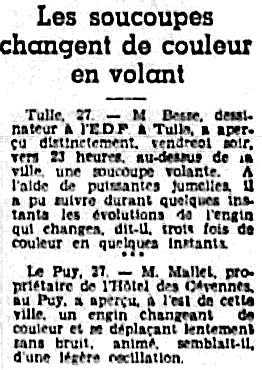
|
Tulle, 27. -- Mr. Besse, designer at the E.D.F. in Tulle, saw distinctly, Friday evening, around 11 p.m., above the city, a flying saucer. Using powerful binoculars, he was able to follow for a few moments the moves of the craft which changed, he said, three times in color in a few moments.
Le Puy, 27. -- Mr. Mallet, owner of the Hôtel des Cévennes, in Le Puy, saw, to the east of this town, a craft changing color and moving slowly without noise, animated, it seemed, of a gentle oscillation.
[Ref. nll1:] NEWSPAPER "NORD LITTORAL":
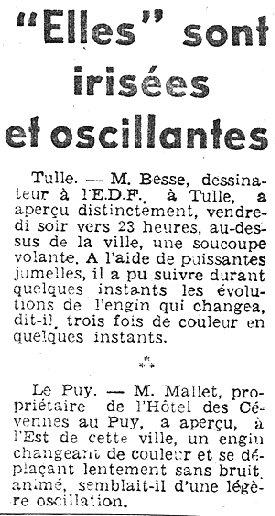
|
Tulle. -- Mr. Besse, designer at the E.D.F., in Tulle, saw clearly on Friday evening around 11/00 p.m., above the city, a flying saucer. With the help of powerful binoculars, he was able to follow for a few moments the moves of the craft which changed, he says, three times its color in a few moments.
Le Puy. - Mr. Mallet, owner of the Hôtel des Cévennes in Le Puy, saw, to the East of this city, a craft changing color and moving slowly without noise, animated it seemed, of a slight oscillation.
[Ref. aup1:] NEWSPAPER "L'AUVERGNAT DE PARIS":

|
Last week, in the night from Friday to Saturday, around 11 p.m., Mr. Besse, designer at the E.D.F., reportedly saw a flying saucer from his balcony.
[Ref. dmi1:] NEWSPAPER "LA DEPECHE DU MIDI":
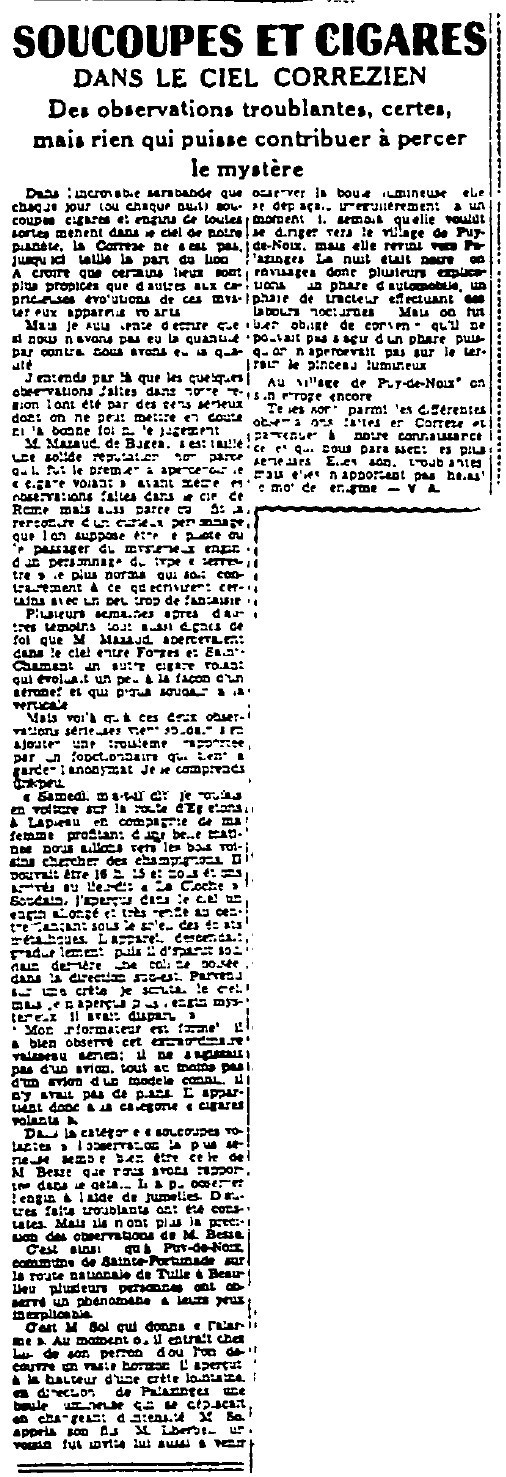
|
In the incredible dance that every day (or every night) saucers and cigars and apparatuses of all kinds lead in the sky of our planet, the Corrèze has not, so far, gotten the lion's share.
But I am tempted to write that if we did not get the quantity however we got the quality.
By this I mean that the few observations made in our region were made by serious people whose good faith and judgment cannot be doubted.
Mr. Mazaud of Bugeat gained a solid reputation not because he was the first to see the "flying cigar" even before the findings made in the sky of Rome, but also because his encounter with a curious person, Which one assumes to be the pilot or passenger of the mysterious machine, a character of the most "terrestrial" type that is contrary to what some write with a little too much fantasy.
Several weeks after other witnesses just as serious as M. Mazaud saw in the sky between Forgès and Saint-Chamont another flying cigar which moved a bit in the manner of an aircraft and which suddenly dove vertically.
But to these two serious observations must be added a third observed by a government employee who wishes to remain anonymous. I understand this a little.
"Saturday," he said, "I drove on the road from Egletons to Lapleau in the company of my wife, enjoying a nice morning we went to the neighboring woods to pick up mushrooms. Suddenly I saw in the sky an elongated machine, very bulging in the center, throwing metallic reflections towards the ground, the apparatus descended gradually, then disappeared suddenly behind the wooded hill in a south-easterly direction. When I reached a ridge I scanned the sky but I realized that the mysterious machine had disappeared.
My informant is formal, he did observe this extraordinary aerial ship; it was not a plane, at least not a plane of any known type. There was no [?]. It therefore belongs to the category of the flying cigars.
In the "flying saucer" category, the most serious observation seems to be that of Mr. Besse, which we did report in detail. He was able to observe the machine using binoculars. Other troubling facts were noted. But they do not have the precision of Mr. Besse's observations.
Thus in Puy-de-Noix, commune of Sainte-Fortunade on the road from Tulle to Beaulieu, several people observed a phenomenon inexplicable in their eyes.
It was Mr. Sol who gave the "alarm". At the moment when he was entering his house, from which he oversees a vast [hamlet?], he perceived at the height of a distant ridge in the direction of Falazinges a luminous ball which was moving, while changing in intensity. Mr. Sol called his son. Mr. Lherbe, a neighbor was also invited to come and observe the luminous ball, it moved irregularly, at one time it seemed that it wanted to go towards the village of Puy-de-Noix, but it returned to Falazinges. The night was dark, so we consider several explanations, an automobile headlight, the headlight of a tractor performing its nocturnal plowing. But we were obliged to consent that it could not be a headlight, since we could not see the luminous beam on the ground.
In the village of Puy-de-Noix, one still wonders about it.
Such are, among the various observations made in the Corrèze, and have come to our knowledge, those that seem the most serious to us. They are troubling but they do not, alas, bring the final word of the enigma. -- V.A.
[Ref. ben1:] "BENJAMIN" MAGAZINE:

|
- EPINAL. - A young butcher boy said he saw a spherical craft of ochre color, encircled by a darker ring.
- LA ROCHELLE. - While driving his car, Mr. Picaud, brewery director, saw a disc moving at low altitude on the horizon.
- LANGEAC (Haute-Loire). - A white glow crossed the sky and was seen by several residents.
- LILLE. - On September 29, a resident of Wimereux, Mr. Raoul Baptiste, 72, a contractor, stated he had seen a saucer at low altitude, heading north.
- LE MAS-NEUF (Lozère). - On September 18, Mr. Jean Madrigal saw a bright object fall from the sky, performing frightening zigzags.
- LE PUY. - On September 24, Mrs. Chaunard saw a red flying cigar, motionless for a quarter of an hour, then it suddenly disappeared. On the 26th, Mr. Mallet, a hotel owner, also spotted one.
- LOUDES (Haute-Loire). - On September 22, a strange craft, described differently by the witnesses, passed through the sky.
- LODEVE (Hérault). - Mr. Hugounenq, an accountant, his wife, and a retired nurse, Miss Marguerite Phallip, saw a flying red fireball.
- NANCY. - On September 24, several DOZENS of workers from Sidelor, especially those living in Fontaine-les-Baroches (Meurthe-et-Moselle), saw six flying cigars.
- ORIGNY (Aisne). - The director of a basketry factory, Mr. Chovel, his wife, and Mr. Sdraulig, his father-in-law, saw at night an orange craft that gradually turned red before disappearing at lightning speed.
- METZ. - On September 22, the rural policeman of Oberdorf informed the gendarmerie that he had seen a flaming craft traveling in zigzags at high speed.
- ORGENOY (Seine-et-Marne). - Mr. Raymond Ravot, butcher-delicatessen owner from Saint-Fargeau, and his daughter Odette noticed a ball of fire moving slowly toward Versailles. Mr. Ravot alerted the town crier of Ponthierry and his wife, Mr. and Mrs. Georges Binet. Together, they saw the craft again.
- SAINT-ETIENNE. - Several residents of Paray-le-Monial noticed on September 21 a large pinkish tube.
- SAINT-FARGEAU. - A ball of fire was seen by Mr. Poulard and his wife. Mr. Poulard works at the National Institute of Patents and Inventions. Mrs. Gaumundi, from Paris, traveling in the same area, saw the same craft.
- TULLE (Corrèze) - Mr. Besse, an engineer with the French Electricity Board, claimed to have seen a saucer turn pink, then green, then yellow.
- VICHY. - A flying cigar was reported by several people, notably by rugby players training at the Vichy stadium.
[Ref. aml1:] AIME MICHEL:
Aimé Michel indicates that there was a sighting with many witnesses in Tulle in the department of Corrèze on September 24, 1954.
He indicates further on this matter that Mr. Besse, draughtsman at Electricity of France, saw a reddish luminous object moving quickly in the sky.
Aided with powerful binoculars, he could follow during a few moments the evolutions of the phenomenon, which changed colors three times, passing from the red to the white, then the green.
He indicates that the source is the newspaper "La Croix" for September 28, 2005.
[Ref. gqy1:] GUY QUINCY:

|
September 24 [1954]
11:00 p.m.: Tulle (Corrèze): luminous obj. ch. color., red, white, green.
[Ref. jve6:] JACQUES VALLEE:
Jacques Vallée indicates that for the day of September 24, 1954, the French Press mentioned a number of sightings, including one in Tulle, in the Corrèze at 11 p.m., of a "single phenomenon".
Jacques Vallée indicates that the observation was of type "IV"; which he defines as an observation where a "abnormal object" was seen in translation movement in the atmosphere, whatever accelerations, luminous variations or rotations this movement would be associated to.
He notes that the observations of the type IV "could be considered insufficient", that half of testimonies of that day "would be rejected within the framework of an official investigation operating on the usual criteria", that the Tulle sighting had only one witness.
[Ref. jve1:] JACQUES VALLEE:
Among the alignments Michel thought he had succeeded in tracing, one in particular catches the attention at first glance. We will take it as an example.
For the single day of September 24, 1954, the French press reported the following sightings, here listed with their classifications:Lantefontaine [Actually Sep. 23], Type IV; Le Puy [Actually Sep. 23], Type IV; Langeac [Actually Sep. 22], Type IV; Tulle [Actually Sep. 22], Type IV; Ussel [Actually Sep. 20], Type I; Gelles [Actually Sep. 17], Type IV; Vichy [exact day not known], Type IV; Lencouacq [Actually Sep. 23], Type I; Bayonne [Actually Sep. 23], Type III.
At least half these eyewitness accounts would be rejected if studied within the limits of the usual official criteria. The Type IV sightings in particular could be judged insufficiently documented. Moreover, the phenomena reported at Tulle and Lencouacq were seen by only one witness. The Gelles sighting was of a "luminous cigar-shaped machine crossing the sky at a quite high speed and without sound." Must we immediately exclude it as being a meteor?
It is clear that the problem is one of method. To reject a measurement made on a known and reproducible physical phenomenon is certainly permissible when a new measurement may improve the accuracy; but to reject a piece of testimony concerning an unknown phenomenon deprives us of a certain quantity of information about the phenomenon and implies that the lost quantity is negligible. But how can we tell whether it really is negligible, since the phenomenon is unknown?
What Michel does is this. He draws a straight line from Bayonne to Vichy (see Figure 12.) This line passes through Lencouacq, Tulle, Ussel and Gelles; of the nine groups of sightings, six are along one and the same straight line. Tracing the straight line from Le Puy to Tulle, we see that it passes through Langeac, No single standard phenomenon (release of a balloon, aircraft flight, etc.) will account for this arrangement. To convince ourselves of this, it is enough to look at the times. The Bayonne and Vichy sightings are dated some time in the afternoon. The Lencouacq sighting falls four hours later. The Gelles sighting is at the beginning of the night. The one at Ussel is still later, and the Tulle case is at 11 P.M. Furthermore, the Bayonne sighting involves a triple object, whereas the other reports speak of single phenomena.
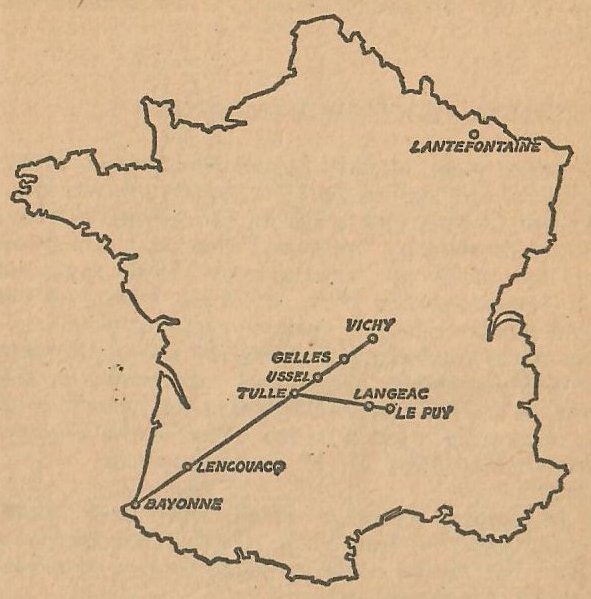
|
[Ref. jve5:] JACQUES VALLEE:
| 143 | -001.74994 | 45.25907 | 24 | 09 | 1954 | 23 | 00 | 102 | TULLE | F | 151144 | C** | 445 |
[Ref. fsy1:] FRANK B. SALISBURY:
4. Tulle, 11 p.m.: M. Besse, with the aid of high-powered binoculars, watched a luminous object move rapidly in the sky, changing color from reddish to white and then to green.
[Ref. fsc1:] FRANCIS SCHAEFFER:

|
Francis SCHAEFER.
ORTHOTENICAL STUDY OF "BRUTUS"
On September 24, 1954, six observations of Spacecraft of Undetermined Origin were found on a 485 kilometers long single line, a line connecting Bayonne and Vichy via Lencouacq, Tulle, Ussel and Gelles; readers who have followed the research of the past years in the orthotenic branch recognize the famous "BAVIC" line which resists all the examinations of the skeptics.
[...]
[Ref. aml4:] AIME MICHEL:
This is how on September 24, 1954, there are in France (and there is only) nine observations: at Lantefontaine [Actually on the 23rd], Vichy [Actually without exact date], Gelles [Actually on the 17th], Ussel [Actually on the 20th], Tulle, Lencouaq [Actually on the 23rd], Bayonne [Actually on the 23rd], Langeac [Actually on the 22nd], Le Puy [Actually on the 23rd]. To check this, one just needs to read "France-Soir" for the 26th, "Paris-Presse" for the 28th, "La Croix" for the 28th, "Le Parisien Libéré" for the 27th, where these observations are recorded.
Checking four Parisian newspapers, it this so tiresome? This being done, let's search this places on a map. One finds that Vichy, Gelles, Ussel, Tulle, Lencouaq and Bayonne are on a single line that is absolutely straight, and that Le Puy and Langeac are on a line with Tulle. Only Lantefontaine is not on a line. So: a) is this true?; b) is this explainable? It is Vallée who went the deepest in the explanation. However he did let this alinement and numerous others unexplained; c) did I invent the four newspapers?; d) is it likely that local correspondents who did not know each other invented all this so that, three years later, it is discovered that they are in line on a large circle?
[Ref. phi2:] "PHENOMENES INCONNUS" UFOLOGY MAGAZINE:
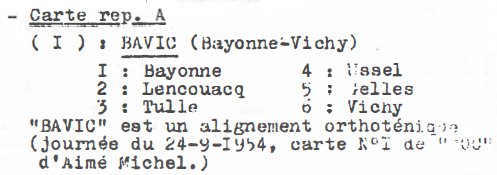
|
- Map rep. A
(I): BAVIC (Bayonne - Vichy)
"BAVIC" is an orthotenic alinement (day of 9/24/1954, map Nr 1 of "MOC" by Aimé Michel.)
[Ref. ioi1:] "INFO-OVNI" UFOLOGY MAGAZINE:
WHAT ABOUT BAVIC IN ALL THIS!
And yes, BAVIC remains! because orthoteny, more or less consciously, has finally identified with this line. For this memorable day of 09/24/1954, it remains undeniable at the challenge of all the "certainties of chance", six places of observation (Vichy, Gelles, Ussel, Tulle, Lencouacq and Bayonne) are yet perfectly alined.
Unable to refute the alignment, many researchers tried to deny any meaning to it.
[Ref. gep1:] UFOLOGY GROUP "GEPO":
| 09 24 54 (13) | Tulle | (cc) 07 03 09 | 107C2 |
[Ref. jsx2:] JACQUES SCORNEAUX:
One point in your argument about the 1954 wave, however, startled me. You write, on p. 24: "Does the BAVIC line, sole survivor of orthoteny, prove that anxiety propagates in a straight line?"
Alas! If we were able to believe for a while that BAVIC survived the general collapse of orthoteny, we must now make up our minds BAVIC has also joined the herd of lines explicable by chance alone, because from the initial six points, there are (latest news...) only three left!
At the time when I was writing my study: "Orthoteny: a disappointed great hope?", published in Inforespace #23 to 27, Pierre GUERIN had already informed me that the so-called case of USSEL had in fact taken place 7 km from the city center, located on BAVIC, and 4.3 km from the line [and October 20]: and one!
Subsequently, the Parisian ufologist M. Jeantheau, who undertook a study investigating the 1954 wave, discovered that the sighting of Bayonne had taken place on September 23 and not 24. Here is how the error occurred: the 24 is the date of publication of the local newspaper, found by Jeantheau, who published the original information, and the article specified: "yesterday, one observed..." The national dailies, which then picked up the news, and that Aimé MICHEL consulted, gave as date that of the local newspaper omitting the "yesterday": and two. Even more recently, Michel Jeantheau found that the case of TULLE was on the 22nd: and three! There are therefore 3 points left on BAVIC on September 24: Lencouacq [the 23rd and not the 24th], Gelles [the 17th], and Vichy [precise day unknown], which chance explains perfectly, since there are about fifteen observations in all that day. One can console oneself by noting that there remains all the same a mystery: by what diabolical chain of involuntary errors of dates and places was Aimé MICHEL led, in all good faith, to find an (imaginary) alignment of six points, high improbable? But the explanation of this series of coincidences that went in the same direction is a purely human phenomenon, and therefore no longer has anything ufological.
[Ref. bbr1:] GERARD BARTHEL AND JACQUES BRUCKER:
The two authors indicates that in the case of Tulle the date of September 24, 1954, is doubtful and the observation is fugitive according to the witness. They add the remark - of which I do not understand the real meaning - that "moreover, Mr. Besse never had the opportunity to observe through binoculars! "
[Ref. fru1:] MICHEL FIGUET AND JEAN-LOUIS RUCHON:
The two authors indicate that in an unknown place, on September 24, 1954 at 11:00 p.m., a "flying saucer" was observed with binoculars by Mr. Besse, draughtsman at the state power company E.D.F.
[Ref. via1:] UFOLOGY BULLETIN "VIMANA 21":

|
FRIDAY, SEPTEMBER 27 [Date of publication]: IRRISED SAUCER... OR ALMOST ... -
Mr. Besse, draftsman at the EDF in Tulle, saw a flying saucer on Friday evening, around 11 p.m., above the city. With powerful binoculars, he was able to follow, for a few moments, the evolution of the machine which changed, he says, three times of color in a few moments.
The Puy - Monsieur Mallet saw east of this city a machine changing color and moving slowly without noise, animated, it seemed, of a slight oscillation.
The source is said to be the newspaper Le Bien Public.
[Ref. lgs1:] LOREN GROSS:

|
September 24th. Tulle (Correze) France.
At 11:00 p.m. on September 24th (which made it the same time as the Lachassagne farm incident) a brighly-lit reddish UFO was seen racing across the dark sky at Tulle (Correze) by a draftsman, M. Besse, who examined the mysterious object with binoculars. While being watched, the UFO did not remain red, but at times changed to white and green. 116.
The source "116" is indicated to be "La Croix. 28 September 54."
[Ref. pha1:] "PHENOMENA" UFOLOGY MAGAZINE:
It is nice to remember that it is his friend, poet Jean Cocteau, who will suggest to Aimé Michel the idea of seeking an order in the observations of the "mysterious celestial objects" that appeared during the autumn of 1954.
To begin with, Aimé Michel painstakingly pointed out on a map the observations of October 14, 1954, made between 06:30 p.m. and 07:35 p.m. His stupefaction will be great in discovering that five points seem to align perfectly. He then resumes all the observations, and reports them, for every 24 hours, on a map. Here again, everything seems to be ordered according to lines of which the most famous, that of September 24, 1954, will be known under the name of "BAVIC line", contraction of BAyonne and VIChy, which will align no less than six observations (Bayonne [in reality on the 23rd], Lencouacq [in reality on the 23rd], Tulle [in reality on the 22nd], Ussel [in reality on the 20th], Gelles [in reality on the 17th] and Vichy) [without precise date].
[Ref. mju1:] MICHEL JEANTHEAU:
Ufologist Michel Jeantheau closely checked the date of this observation allegedly being one of the points of an alignment of sightings claimed by ufologist Aimé Michel and called "the BAVIC line" for "BAyonne-VIChy."
He thinks that Aimé Michel used the date of "Friday" given in the newspaper Le Parisien Libéré for September 27, 1954. But he found in the local newspaper "L'Echo de la Corrèze", of Tulle, for October 1, 1954, on page 1, an article which deals with this observation.
In the article, the witness himself speaks, questioned by a journalist. His declaration starts with these words: "on October 22, at 09:00 p.m., I was returning from a short walk with my wife and my son; we had arrived on the bridge of Souilhac when..."
But the date given is "October 22", which is an obvious error, the date being rather September 22, since the newspaper is dated from October 1st. The indicated time is 09:00 p.m., not 11:00 p.m.
[Ref. jca1:] JACQUES COSTAGLIOLA:
The author indicates that on September 24, 1954, there were 9 sightings, 6 being on the Bayonne - Vichy line, one of those sighting was at Tulle.
[Ref. lcn1:] LUC CHASTAN:
Luc Chastan indicates that in the Corrèze in Tulle on September 22, 1954, at 23:00 "A witness sees a reddish luminous object moving quickly in the sky. Using binoculars, he observes that the object changes color three times passing from the red to the green then the white."
Luc Chastan indicates that the source is "M.O.C. by Michel Aimé ** Arthaud 1958".
[Ref. uda1:] "UFODNA" WEBSITE:
The website indicates that on 24 September 1954 at 23:00 in Tulle, France, "An unidentified object was sighted, but with appearance and behavior that most likely would have a conventional explanation. One object was observed by one witness for two minutes (Besse)."
The sources are indicated as "Michel, Aime, Flying Saucers and the Straight-Line Mystery, S. G. Phillips, New York, 1958; Vallee, Jacques, Computerized Catalog (N = 3073); Vallee, Jacques, Challenge to Science: The UFO Enigma, Henry Regnery, Chicago, 1966; Vallee, Jacques, Preliminary Catalog (N = 500), (in JVallee01)".
[Ref. ubk1:] "UFO-DATENBANK":
| Case Nr. | New case Nr. | Investigator | Date of observation | Zip | Place of observation | Country of observation | Hour of observation | Classification | Comments | Identification |
|---|---|---|---|---|---|---|---|---|---|---|
| 19540924 | 24.09.1954 | Tulle | France | 23.00 | NL | |||||
| 19540924 | 24.09.1954 | Tulle | France | 23.00 | NL | |||||
| 19540924 | 24.09.1954 | Tulle | France | 23.00 | NL | |||||
| 19540924 | 24.09.1954 | Tulle | France |
[Ref. wia1:] "WIKIPEDIA FR" WEBSITE:
|
|
In their web page about the 1954 French flap in France, Wikipedia FR mentions 21 sightings of the "flap", including:
[... other cases...]
September 24 [, 1954]: ufos are observed in six cities [in reality at least 11] (Bayonne [in reality the 23rd], Lencouacq [in reality the 23rd], Tulle, Ussel [in reality the 20th], Gelles [in reality the 18th], Vichy) [in reality with no precise day].
[... other cases...]
No source is given. The links in the page lead to general information web pages about these places.
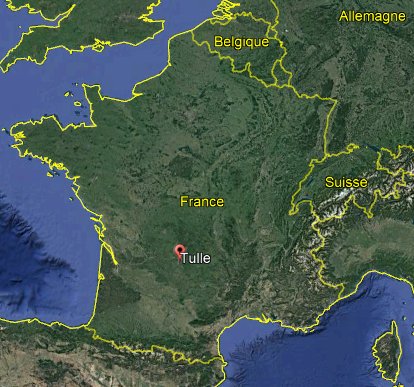
|
I found the case in the US newspaper The Newark Star-Ledger for September 24, 1954 [nsl1]. This shows that the case cannot be dated September 24, 1954.
The date of September 22nd found by Jeantheau is perhaps correct; but it is not absolutely certain either. If it was really on a "Friday", it could be September 17, 1954, maybe.
As for the observation, the data is very insufficient, it may have been an astronomical misinterpretation.
(These keywords are only to help queries and are not implying anything.)
Tulle, Corrèze, Jean Besse, binoculars, red, white, green, night, draughtsman, colors
[----] indicates sources that are not yet available to me.
| Version: | Created/Changed by: | Date: | Change Description: |
|---|---|---|---|
| 0.1 | Patrick Gross | March 23, 2006 | First published. |
| 1.0 | Patrick Gross | January 17, 2010 | Conversion from HTML to XHTML Strict. First formal version. Addition [lcn1]. |
| 1.1 | Patrick Gross | February 10, 2010 | Additions [jca1], [uda1]. |
| 1.2 | Patrick Gross | June 17, 2010 | Addition [jve5]. |
| 1.3 | Patrick Gross | July 2, 2010 | Addition [jve6]. |
| 1.4 | Patrick Gross | November 3, 2016 | Additions [ler1], [ubk1]. |
| 1.5 | Patrick Gross | January 7, 2017 | Addition [dmi1]. |
| 1.6 | Patrick Gross | August 28, 2019 | Additions [fsc1], [aml4], [phi2], [ioi1], [via1], [pha1], Summary. Explanations changed, were "Probably astronomical." |
| 1.7 | Patrick Gross | February 21, 2020 | Addition [nnm1]. |
| 1.8 | Patrick Gross | January 23, 2021 | Addition [lcx1]. |
| 1.9 | Patrick Gross | January 27, 2021 | Addition [aup1]. |
| 2.0 | Patrick Gross | March 20, 2021 | Addition [gqy1]. |
| 2.1 | Patrick Gross | April 13, 2022 | Additions [gep1], [lgs1]. |
| 2.2 | Patrick Gross | May 20, 2022 | Additions [jsx2], [wia1]. |
| 2.3 | Patrick Gross | June 13, 2022 | Addition [jve1]. |
| 2.4 | Patrick Gross | May 7, 2025 | Addition [bpc1]. |
| 2.5 | Patrick Gross | May 13, 2025 | Addition [brn1]. |
| 2.6 | Patrick Gross | June 3, 2025 | Addition [cot1]. |
| 2.7 | Patrick Gross | June 20, 2025 | Addition [tbt1]. |
| 2.8 | Patrick Gross | July 27, 2025 | Addition [rln1]. |
| 2.9 | Patrick Gross | August 31, 2025 | Addition [ben1]. |